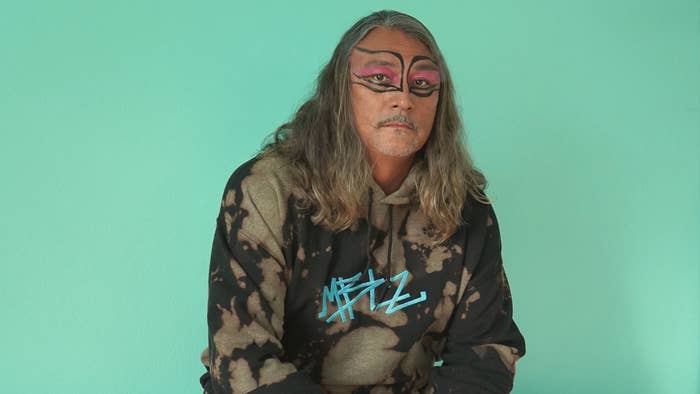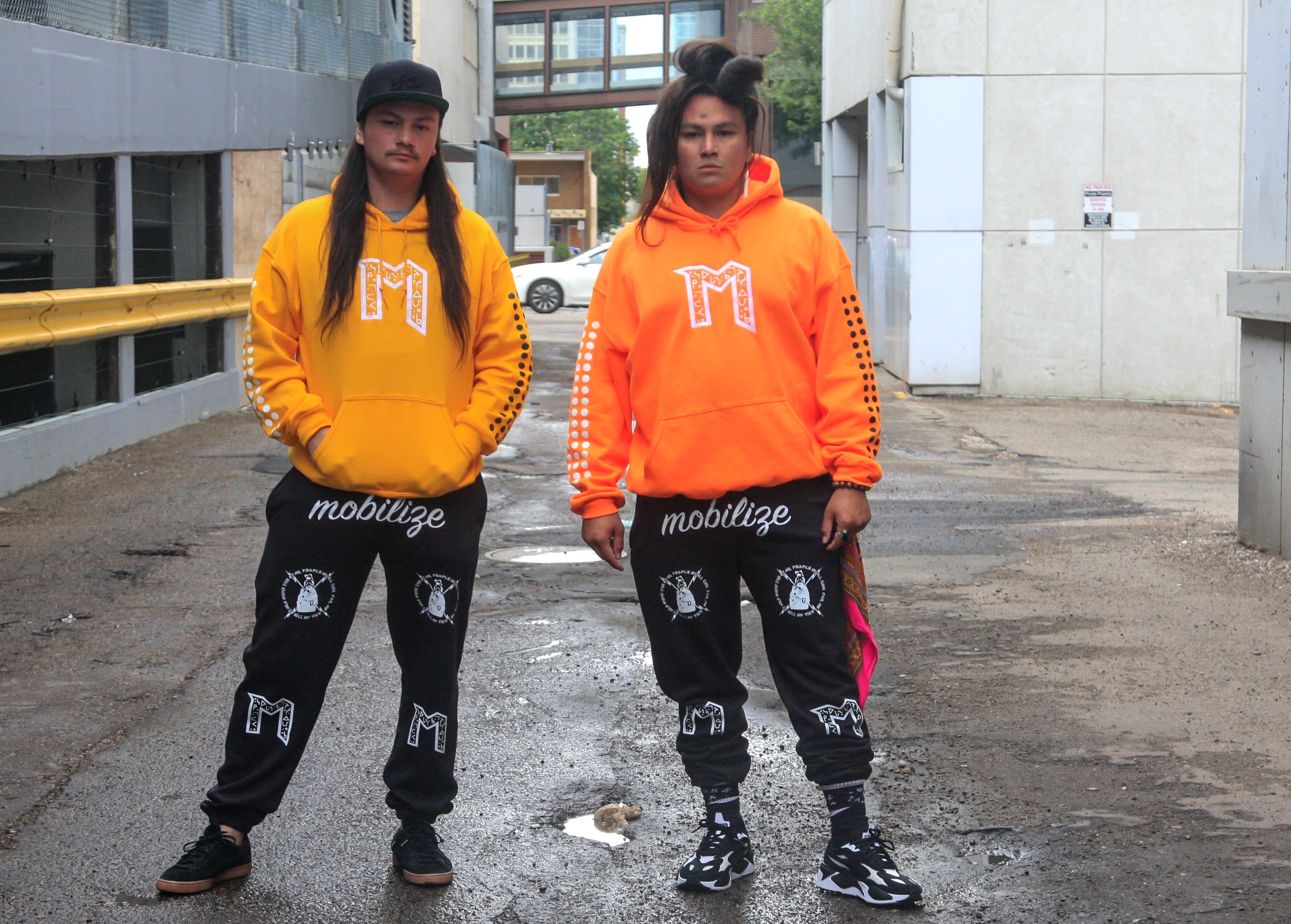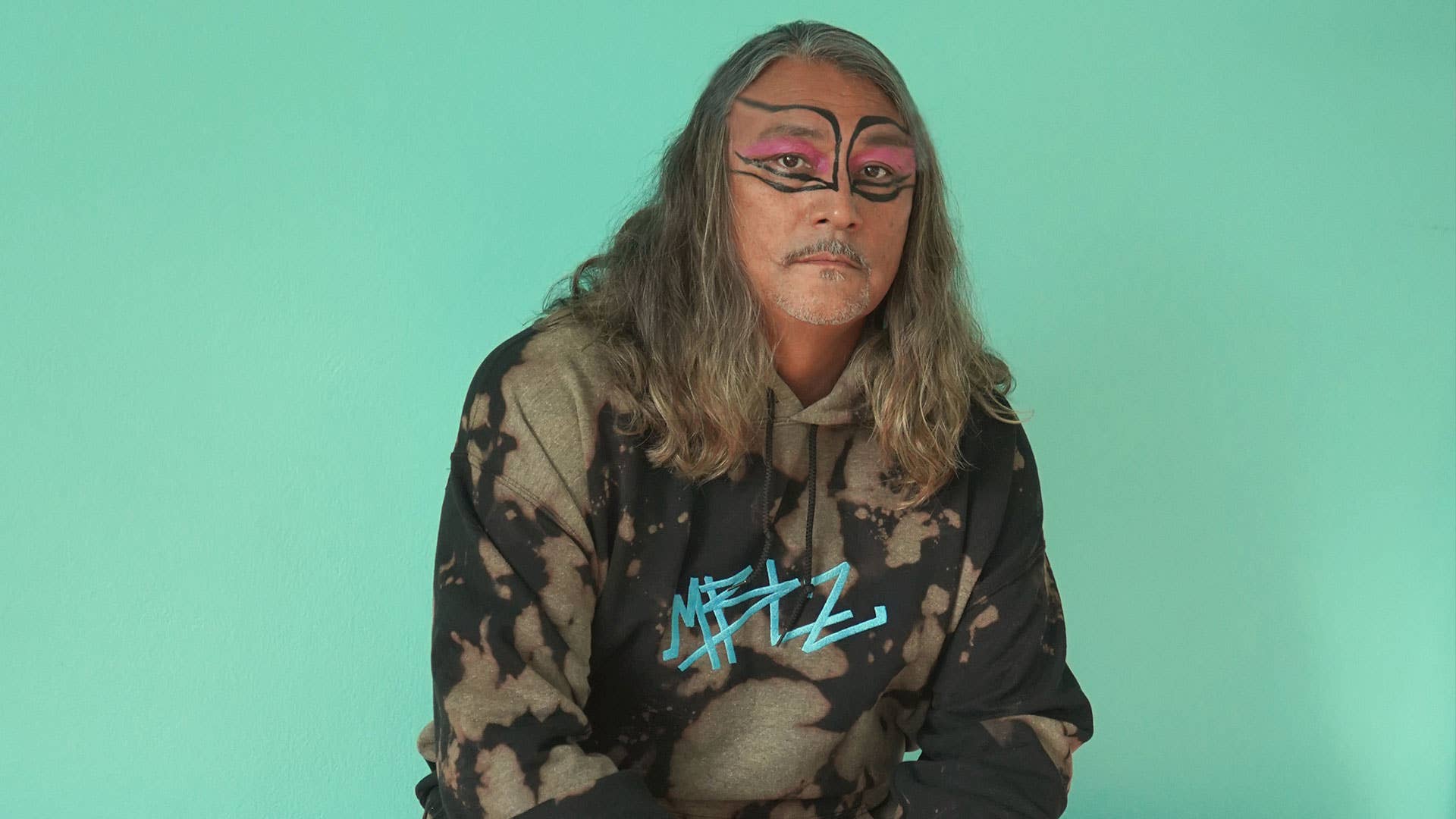
The model didn’t merely strike a pose on the runway. Instead, fashionista and performance artist Cheyenne Rain LeGrande reached up with her secretly paint-soaked palms. Then, she smeared her face blood red. Among the shocked, well-to-do spectators sat LeGrande’s brother Dusty, the designer of the streetwear she had donned for the catwalk.
Dusty LeGrande, the Cree founder of Edmonton Indigenous brand Mobilize couldn’t have been prouder of his sister for collaborating with him on that bold statement. It was meant to reflect, among other things, the trauma Indigenous Canadians have endured.
Dusty often loves to spin tales with his threads, telling Complex Canada: “It depends on the space. Sometimes we’ll bring b-boys and dancers and share joy and love, especially in Indigenous spaces where everyone who has come to see our designs is aware of our pain. But sometimes we have to bring those deeper, harder-to-swallow messages. Because it’s important that people don’t forget.” And what of Cheyenne’s message with the paint on the catwalk? She says: “The red smeared across my face represented race, history, pain, trauma, blood, and protection. Performance art allows me to speak to my experience as an Indigenous person, and I am so thankful to have the platform to do so at a fashion event. It was an honour to have that visibility.”
Such pointed social commentary hasn’t slowed Mobilize’s commercial progress. On the contrary—Dusty’s works have not only been featured in a number of high-profile fashion shows, but also in a glossy Vogue magazine spread (featuring photos of his brother, Nikaeo, taken by Cheyenne). What’s more, this spring, Mobilize will be sold at 50 of international skater chain Zumiez’s stores, thanks to a viral TikTok video showcasing Dusty’s designs that caught the eyes of the company’s higher ups.
Below, Dusty Legrande tells us about fusing the hip-hop he grew up with to his underrepresented Cree culture, making his mark on Canada’s swiftly ascending Indigenous rap scene, and more.

How did streetwear and hip-hop culture first inspire you?And how did you realize you could mix them with your Cree heritage?
Fashion is created constantly in many Indigenous communities. But it’s not really mainstream. A lot of T-shirts with really cool imagery exist in those spaces. At first, I would purchase from other designers. Then, I’d turn them into patches—different Indigenous nations have certain fabrics and prints that represent them, so I’d use these different elements to show who I was. As an Indigenous person, I didn’t learn a lot about my culture because of the church. During my teenage years, I separated from the church and began learning about who I was, and the history of my people.
Growing up, hip-hop culture was a mix of Indigenous and Black people in the communities I was a part of. It was a part of my representation. And I always loved streetwear because it wasn’t just clothing—it was political, it had a voice. As I got older, I would customize my own clothes, bringing an Indigenous flavour to them. That had existed in the powwow scene—Indigenous people would put patches representing their nation on T-shirts and things like that. So I would take these pieces and put them together for my own custom denims, and upcycle things. I was working with Indigenous youth at this part of my life, in a mentorship role. One of the things we’d do is go to the malls all the time. Zumiez was one of the stores we’d visit. The kids would ask me where I shopped for my own stuff; Zumiez was the spot. So when I started the brand, Zumiez was always a goal for it, because I remember those moments of walking in with Indigenous youth, looking at the walls, and wondering what it would mean to them to see representation. To see themselves on those walls. A lot of the youth I worked with—because of the care system that trickled down from residential schools, the child welfare system in Canada—they were disconnected from their culture. As their mentor, I got to connect them to their culture. But I wanted it to be accessible to them in a stream that they already vibed with. And streetwear is the people’s clothing today. Hip-hop speaks to them, and they understand its struggle and roots. It was something we mutually appreciated.
“I view my work as kicking down doors, like: ‘Yo, I don’t know if any Indigenous streetwear designers have been in here. But I’m going to get in here, so my kids and the others coming after us can see it’s possible.’”
How did you begin bridging your love of hip-hop with your Cree heritage?
I wanted my fashion to become a space where I could be loud with designs, and let everyone know Indigenous people are still here, still strong, and still present without having to say a word. It would just exist on my clothing.
That inspired me to study historical Cree clothing, and how it would represent who we were. Based on the types hydes or furs you wore, it showed the types of land you lived on, the animals that were around, and who you traded with. And if people were leaders or were known for something or had a special gift, it would be present on their clothing and then people would know. Bringing these concepts to life myself was the root of developing my brand. I’d think, Wow, this doesn’t exist here in Edmonton. And we need this! That’s where it came from: taking these pieces, and having representation, and having that on your clothing. Then people could just read it, and learn for themselves. Social media was also an important part of it, for activism. I wanted to speak authentically through a platform, educate people, and empower others to speak.

Tell us about your early designs.
I called my first design the Matriarchy Hoodie. Because I come from a matriarchal Indigenous system. We honour our women, our life-givers, and a lot of the leadership roles are held by women. That was the very first piece I released, and it was important for me to tell that story. This colonial patriarchy has built all these hierarchies, and as Indigenous people, we have a different perspective to bring. I have three daughters, and as their father it was vital for me to tell that story to begin the brand. Everything that I’ve done has taken a long time. Indigenous art, my own process, is very thought out. It takes a lot of writing and putting things together until it all feels ready. Each design has its own story and elements that allow me to connect to people on a human level.
And what about your more recent designs?
I have one called the Next-Gen Hoodie. I designed it while flying to Vancouver. While I was in the air, I began thinking about how we believe our ancestors are in the stars. At the time, I was working on a scholarship for emerging Indigenous designers called The Next Gen Scholarship. As that story came together in my mind, I began working on the design for this piece. I’d then bring in different elements— that piece also has dots running down its arms in rows of four, because that is one of our sacred numbers as Indigenous people. And traditional Cree tattoos were often done in patterns of dots. Bringing these elements to the mainstream allows me to share a story about where our traditions come from and what they represent.
My oldest daughter is working on her fourth hoodie now. We debuted her first when she was four years old— she brought some paper to me, chopped it up at different angles so it was no longer a square, and covered it in squiggly lines that made it look like abstract art. And that design sold out in two days. She would flip the design different ways, and from each angle tell me a new story about what it represented. She’d say: That part’s mountains now, and that’s a bear,” then turn it and say, “That’s waterways now.” Then I’d sit at my computer, and put her art into a digital format. It’s really dope to have my kids see what I do, and be inspired to design. I’ll bring up a hoodie on my computer screen, and my daughter will sometimes choose the colours, giving input on the logo, and more. That’s who Indigenous people are as well: it’s about our community. We try to stay in balance with each other, and it’s not about competition. So I do a lot of collaboration as well, because I like bringing other artists to light. We’ll split it in half: “You design the front and the right arm, I’ll design the back and the left arm.” We’ll work off each other’s art, and it’s a fun way to keep it real and tell these stories from our perspective.

Having honed that process, how did it feel to bring your designs to this year’s Indigenous Fashion Week Toronto (IFWTO), which Vogue wrote about late last year?
It’s one of North America’s biggest Indigenous fashion expos. It has a market and showcases designers from around the world, which is really cool. It was supposed to happen in May, but because of the pandemic they moved it online. We designed our collections and sent them to Toronto, and then they filmed them for mini fashion films shown at the expo for four nights. I was one of only two or three streetwear designers invited to apply, and one of only about ten designers from Canada that participated.
“When people are standing up and using their voices, they are also healing generations that were silenced.”
How did it feel to see your designs in those mini-movies?
It was pretty cool. One thing I’ve always done, especially because I’m a streetwear designer, is keep it real to who I am. I don’t think a lot of streetwear blends with the fashion world in that way. But I’ve been invited to a lot of those things for some reason, probably because I do higher-end streetwear for those events. It’s a space that is still so backward.
How so?
There’s still a lot of body shaming. They still have their old rules. So what I get to do in these spaces is bring something different. I’ll bring b-boys, dancers, performers. My sister, who is a performance artist, painted her face on a runway with blood-red paint. For me, it’s a form of storytelling. It’s me telling people what this Indigenous experience is from my perspective. How close the Residential School trauma is to my family, to my bloodline, how I see it presently.
In those spaces, it’s about taking that energy and educating people. Especially in the fashion world. Because it has been appropriating Indigenous fashion for so long. But they haven’t seen the real Indigenous fashion, or even our authentic streetwear. I feel like there’s a duty to rep in that way.
So for spaces like IFWTO to be able to represent my territory is amazing. I also did collabs with a few artists there like Sabr, who is Black, Muslim, and female. For those collaborators, it was their first time showing their gear at this big event. Then, we ended up getting featured in Vogue. All these young artists that I collaborated with came along for the journey. I’m a Cree person, and our first great law is of love. I want to bring people together, to mobilize them.
Hence the name of your band?
Well, for events like that, it’s not just myself or the brand going. It’s a representation of the community I come from, and who we are. Who my circle is. For me, it’s really cool to see my stuff in those spaces, because it’s something I always hoped would happen and was planning for. I was building toward that for a long time, because a big part of the reason why I started this brand was for representation.
What has it been like to try and boost that visibility?
I was driven by years of walking into spaces and not seeing anything that represented Indigenous people. Especially in Canada because we’re still here and very present—I know so many people who come from strong nations but they live in rural areas, so you just don’t see them that much. But the culture is still strong.
I also wanted to challenge what Indigenous art is perceived as, versus what it really is. There’s so much more substance and depth to it, that so many people don’t know. For a lot of us designers and artists, it’s about bringing that representation to the world on big scales. However we can. And I view my work as kicking down doors, like: “Yo, I don’t know if any Indigenous streetwear designers have been in here. But I’m going to get in here, so my kids and the others coming after us can see it’s possible.”
With the trauma that’s going on, a lot of our people are still healing. In my family, I’m one of the first that’s willing to publicly speak on these things and bring awareness. It’s very layered in the approach, and a lot of it is so my three kids can see possibility in the world and create what they dream of.
Did you try to commentate on such recent traumas with your designs—such as last year’s fishing dispute in Nova Scotia, or the pipeline railway protests?
Part of the Indigenous movement is about taking power back. When people are standing up and using their voices, they are also healing generations that were silenced. It’s vital that it happens. And I try to show support in any ways I can with my platform. But, being a father, I’ve been taught by my elders that my first responsibility is to my family. Because a lot of times I’ll want to join, like the protests at Standing Rock.
So I’ll try to find creative ways, through my platform at home with my family, to be able to inspire people to support these causes. I’ve had pieces that raised funds for Indigenous people who are living rough here in Edmonton and need support. And as an Indigenous person whose business is growing, I’m going to stay focused on helping my community heal and grow. I have put out certain pieces that are very political, that speak to both what matters to us and against colonial capitalism.
You spoke about the importance of not only community but also collaboration earlier. Some of your most famous fans are rising Canadian rap duo Snotty Nose Rez Kids. Do they share your spirit of activism, and your drive to raise awareness?
They are one of my favorite hip-hop groups. When I started Mobilize, I knew I wanted to get them repping the brand, and rocking my hoodies! We got in touch and they’ve rocked our gear at different shows, which was really rad. But last year, they actually shouted out the brand in one of their songs on their new album. That was a pretty dope moment.
When Snotty Nose came to town, I hit them up. And I want to bring them back to my city, and bring A Tribe Called Red here. We have dope MCs and poets in Edmonton, and I want to connect them with bigger acts. I want to do a hip-hop festival in my city, because Edmonton hasn’t had an all-Indigenous hip-hop event. And it’d be great to do it digitally if the pandemic lockdowns haven’t been lifted.
Aside from those local musicians, your biggest collaborators are arguably your siblings. Cheyenne told Complex Canada: “Dusty and I both storytell through our art and use the body to do so. We explore generational ties and speak to our experience as an Nehiyaw [an alternative name for Cree] people. We investigate past history, knowledge and traditional practices, bringing our ancestors with us, in the larger movement towards decolonization.” How does it feel to hear that?
It was very meaningful to work with her on the performance art piece for the runway. When she was living in Vancouver, as her older borher, I always worried something could happen to her. It’s important for us to show those who aren’t aware, or are indifferent to our missing and murdered Indigenous women: “Yo, we are here. We are powerful. We’re going to be loud. And if you aren’t going to talk about it, we will.”
And what was it like to see your sister surprise the audience with that piece of performance art?
That moment was most special for me. Watching her do that, it made me feel two feet taller.

